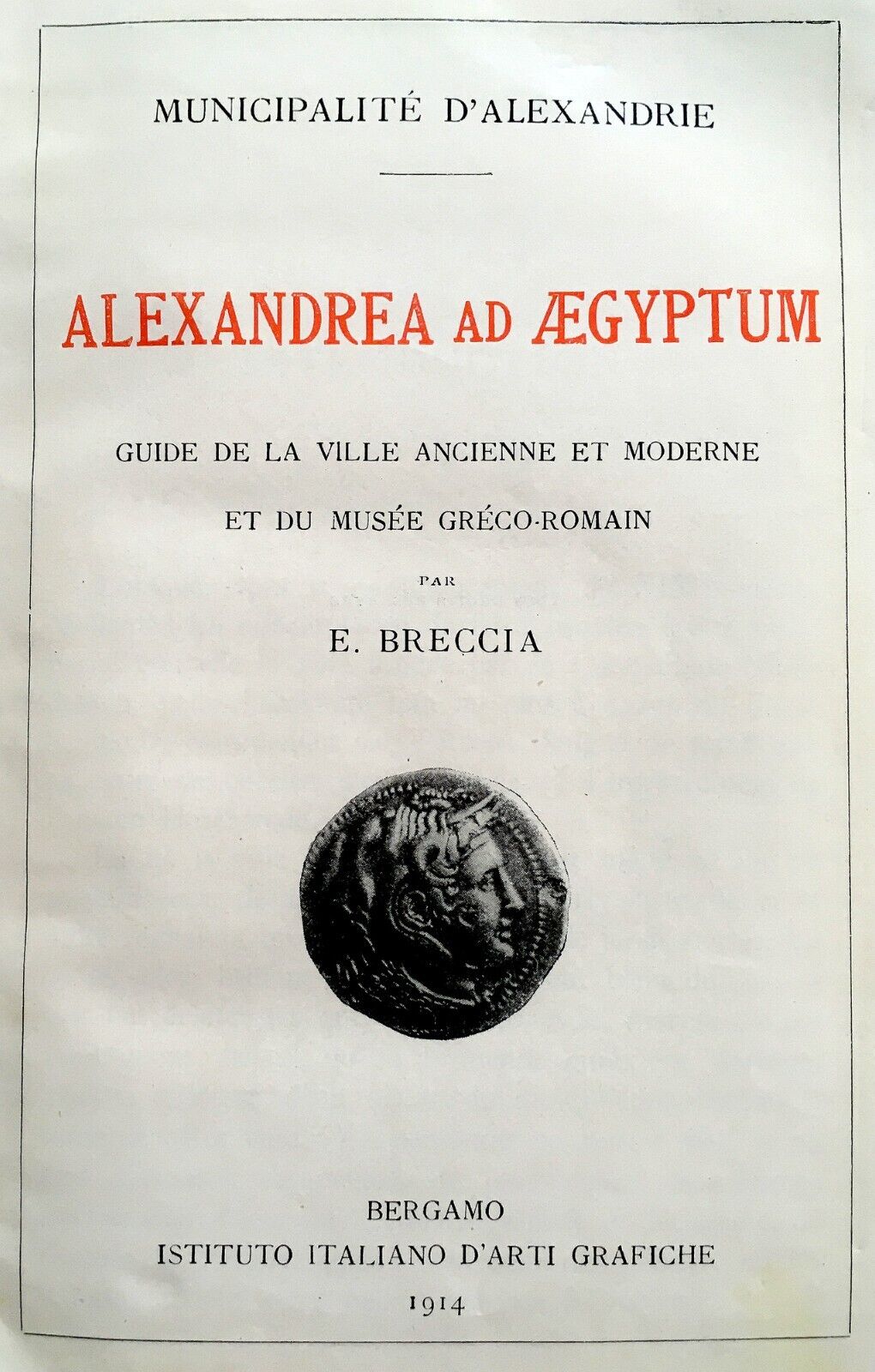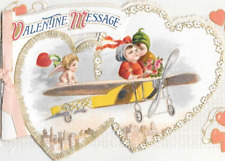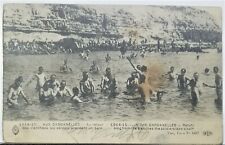When you click on links to various merchants on this site and make a purchase, this can result in this site earning a commission. Affiliate programs and affiliations include, but are not limited to, the eBay Partner Network.
DESCRIPTION:Kindly note : For sale is the ORIGINAL 1914 FIRST EDITION and FIRST PRINTING of this RARITY - Not a recent REPRINT or FACSIMILE EDITION !!! Only one other original copy can be found ON LINE !!!Up for sale is the EXTREMELY RARE and MOSTLY SOUGHT AFTER original 1914 first and only edition of the extensive research TRAVEL - GUIDE BOO book \"ALEXANDREA AD AEGYPTUM- GUIDE DE LA VILLE ANCIENNE ET MODERNE ET DU MUSEE GRECO-ROMAN \" ( A GUIDE TO THE ANCIENT AND MODERN TOWN AND TO ITS GRAECO - ROMAN MUSEUM ) . A profusion of DATA in thorough explanatory TEXT , Numerous PHOTOS and ILLUSTRATIONS in COLOR and B&W and MAPS ( Including a larger folding map in a rear pocket ) of theANCIENT AND MODERN TOWN of ALEXANDRIA in EGYPT and its GRAECO-ROMAN Museum. This ULTRA RARE guide is being an important and thorough guide to the contents of the Graeco-Roman museum of Alexandria, which now ceased to exist, as it has been \"closed for renovation\" for over 15 years now, with seemingly no hope of restoring the building as it was, nor its contents. It had hundreds, or even thousands of important artifacts from Alexandria and other parts of Egypt.Written almost a hundred years ago, this book highlights some archaeological sites and discoveries that were recent at the time. It is a partial guide to the beautiful Alexandria and how it was. It makes you wonder how such a beautiful city could change drastically in one century to become what it is now.Published byIstituto Italiano d\'Arti Grafiche., Bergamo.,1914.FIRST EDITION ( Except later facsimiles etc ) . FRENCH. Size 7\" x 5\". Original illustrated COLORFUL cloth HC. Gilt embossed headings on cover and spine. 320 pp plus additional unpaged CHROMO colored PHOTO PLATES . Larger FOLDED MAP in rear pocket .Very goodcondition. Tightly bound. Perfectly clean. Very well kept copy. Very slight cover wear.( Please look at scan for actual AS IS images )Book will be sent in a special protective rigid sealed package.PAYMENTS: Payment method accepted : Paypal & All credit cards .SHIPPMENT:SHIPP worldwide via registered airmail is $25.Book will be sent inside a protective packaging.Handling around 5-10 days after payment.
TheGraeco-Roman Museumis anarchaeological museumlocated inAlexandria,Egypt.Contents1 History2 Notable people3 Gallery4 See also5 References6 External linksHistory[edit]Erected in 1892, it was first built in a five-room apartment, inside one small building on Rosetta Street (later Avenue Canope and now Horriya). In 1895, it was transferred to another, larger building near Gamal Abdul Nasser Street. The museum contains several pieces dating from theGreco-Roman(Ptolemaic) era in the 3rd century BC, such as a sculpture ofApisinblack granite, thesacred bullof the and other objects offering a view ofGreco-Roman civilizationin contact withancient Egypt.The museum\'s collection is the product of donations from wealthy Alexandrians as well as of excavations led by successive directors of the institution, both within the town and in its environs. Certain other objects have come from the Organization of Antiquities atCairo(particularly those of thePharaonicperiod) and from various digs undertaken at the beginning of the century inFayoumand at Benhasa. Housed within a historic building whose beautifulneoclassicalfacadeof six columns andpedimentbears the large Greek inscription ‘MOYΣEION’ (\"MOUSEION\"). The museum consists of 27 halls and an attractive garden, which offer an excellent introduction to Egypt\'s Greco-Roman period.The museum has been closed for renovations since 2005.[1]As of June 2017, the building was still surrounded byscaffolding. thethird-largest cityin Egypt afterCairoandGiza, theseventh-largest cityinAfrica, and a major economic centre. Called the \"Bride of the Mediterranean\" by locals,[citation needed]Alexandria is the largest city on the Mediterranean, thefourth-largest cityin theArab world, and theninth-largesturban area in Africa. The city extends about 40km (25mi) at thenorthern coast of Egyptalong theMediterranean Sea. Alexandria is a popular tourist destination, and an important industrial centre due to itsnatural gasandoilpipelinesfromSuez.Alexandria was founded inc. 331 BCbyAlexander the Great[10]on the site of an existing settlement namedRhacotis(that became the Egyptian quarter of the city). Alexandria grew rapidly, becoming a major centre ofHellenic civilisation, and replacingMemphisas Egypt\'s capital during the reign of thePtolemaic pharaohswho succeeded Alexander. It retained this status for almost a millennium, through the period ofRoman and Eastern Roman (Byzantine) ruleuntil theMuslim conquest of Egyptin 641 AD, when a new capital was founded atFustat(later absorbed intoCairo).Alexandria was best known for theLighthouse of Alexandria(Pharos), one of theSeven Wonders of the Ancient World, itsGreat Library(the largest in the ancient world), and theNecropolis, one of theSeven Wonders of the Middle Ages. Alexandria was the intellectual and cultural centre of the ancient Mediterranean for much of theHellenistic ageandlate antiquity.[10]It was at one time the largest city in the ancient world before being eventually overtaken byRome.The city was a major centre ofearly Christianity, and was the centre of thePatriarchate of Alexandria, which was one of the major centres of Christianity in theEastern Roman Empire. In the modern world, theCoptic Orthodox Church, and theGreek Orthodox Church of Alexandriaboth lay claim to this ancient heritage.By the time of the Arab conquest of Egypt in 641 AD, the city had already been largely plundered and lost its significance before re-emerging in the modern era.[11]From the late 18th century, Alexandria became a major centre of the international shipping industry and one of the most important trading centres in the world, both because it profited from the easy overland connection between the Mediterranean Sea and theRed Sea, and the lucrative trade inEgyptian cotton. ****The term \"Greco-Roman world\" (also \"Greco-Roman spelledGraeco-Romanin theCommonwealth), as understood by modern scholars and writers, refers to geographical regions and countries that culturally—and so historically—were directly and intimately influenced by the language, culture, government and religion of theancient GreeksandRomans. A better-known term isclassical civilization. In exact terms the area refers to the\"Mediterranean world\", the extensive tracts of land centered on theMediterraneanandBlack SeaBasins, the \"swimming pool and spa\" of the Greeks and the Romans, in which those peoples\' cultural perceptions, ideas, and sensitivities became dominant inclassical antiquity.That process was aided by the universal adoption ofGreekas the language of intellectual culture and commerce in the EasternMediterranean Seaand ofLatinas the language ofpublic administrationand offorensic advocacy, especially in the Western Mediterranean.Greek and Latin were never the native languages of many or most of the rural peasants, who formed the great majority of theRoman Empire\'s population, but they became the languages of theurbanandcosmopolitanelitesand the Empire\'slingua franca, even if only as corrupt or multifarious dialects for those who lived within the large territories and populations outside theMacedonian settlementsand theRoman colonies. All Roman citizens of note and accomplishment, regardless of their ethnic extractions, spoke and wrote in Greek or Latin. Examples include the Roman jurist and imperial chancellorUlpian, who was ofPhoenicianorigin; the mathematician and geographerClaudius Ptolemy, who was ofGreco-Egyptianorigin; and the famous post-Constantinian thinkersJohn ChrysostomandAugustine, who were ofSyrianandBerberorigins respectively. Note too the historianJosephus Flavius, who was ofJewishorigin but spoke and wrote in Greek. ****Ancient Egyptwas acivilizationofancientNorth Africa, concentrated along the lower reaches of theNile River, situated in the place that is now the countryEgypt. Ancient Egyptian civilization followedprehistoric Egyptand coalesced around 3100BC(according toconventional Egyptian chronology)[1]with the political unification ofUpper and Lower EgyptunderMenes(often identified withNarmer).[2]Thehistory of ancient Egyptoccurred as a series of stable kingdoms, separated by periods of relative instability known as Intermediate Periods: theOld Kingdomof theEarly Bronze Age, theMiddle Kingdomof theMiddle Bronze Ageand theNew Kingdomof theLate Bronze Age.Egypt reached the pinnacle of its power in the New Kingdom, ruling much ofNubiaand a sizable portion of theNear East, after which it entered a period of slow decline. During the course of its history Egypt was invaded or conquered by a number of foreign powers, including theHyksos, theLibyans, theNubians, theAssyrians, theAchaemenid Persians, and theMacedoniansunder the command ofAlexander the Great. The GreekPtolemaic Kingdom, formed in the aftermath of Alexander\'s death, ruled Egypt until 30BC, when, underCleopatra, it fell to theRoman Empireand becamea Roman province.[3]The success of ancient Egyptian civilization came partly from its ability to adapt to the conditions of theNile River valley for agriculture. The predictablefloodingand controlledirrigationof the fertile valley produced surplus crops, which supported a more dense population, andsocial developmentand culture. With resources to spare, theadministrationsponsored mineral exploitation of the valley and surrounding desert regions, the early development of an independentwriting system, the organization of collective construction and agricultural projects, trade with surrounding regions, anda militaryintended to assert Egyptian dominance. Motivating and organizing these activities was a bureaucracy of elitescribes, religious leaders, and administrators under the control of apharaoh, who ensured the cooperation and unity of the Egyptian people in the context of an elaborate system ofreligious beliefs.[4]The many achievements of the ancient Egyptians include thequarrying,surveyingand construction techniques that supported the building of monumentalpyramids,temples, andobelisks; a system ofmathematics, a practical and effectivesystem of medicine, irrigation systems and agricultural production techniques, the first known planked boats,[5]Egyptian faienceand glass technology, new forms ofliterature, and theearliest known peace treaty, made with the Hittites.[6]Ancient Egypt has left a lasting legacy. Itsartandarchitecturewere widely copied, and its antiquities carried off to far corners of the world. Its monumental ruins haveinspired the imaginationsof travelers and writers for millennia. A newfound respect for antiquities and excavations in the early modern period by Europeans and Egyptians led to thescientific investigationof Egyptian civilization and a greater appreciation of its cultural legacy.[7].[83]5523/199






